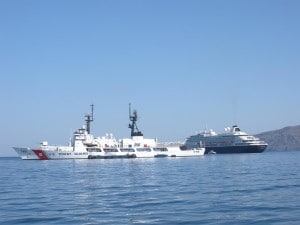 Captain Albert Schoonderbeek
Captain Albert Schoonderbeek
When I approach Santorini with the ship I always have to remind myself that, no we are not crazy and yes in this case it is normal to sail into a Volcano crater. It is big enough and there is plenty of water but still it is a bit strange to do so. However it is an impressive experience when you sail around the central volcano cone towards the East shore where the most important villages are located. There are two entrances to the area, one from the South West and one from the North West. As we were coming from the Lower West we used the SW entrance as it was the shorter route.
The routine is for most cruise ships the same; first you go to O’Athinios to disembark the overland tour and then you slowly sail to Skala Fira where the tender docks for access to Thira which sits on top of the Cliff. As mentioned yesterday, the Prinsendam would have to drift all day, as a warship was at the anchorage. So I was intrigued to find out what sort of warship that would be. When we came around the corner we saw that it was a USCG cutter, taking on bunkers and doing some R&R.
Confusion reigned as they identified themselves as warship 917, while we could clearly see it’s was a USCG boat. Maybe the department of Transport was starting their own navy or something. However 917 rang a bell, I remembered that number from something and thought it could not be. But it was. The 917 was the same USCG cutter Boutwell that had played a very significant role in the sea rescue of the guests of the first Prinsendam in October 1980 when it caught fire in the Gulf of Alaska. It was thus a bit strange to see the Boutwell here in the Mediterranean and to have it meeting up with the 2nd Prinsendam. I joined the company a year later but I remember that there was a great feeling of gratitude among everybody for the work of the crew of the Boutwell during that operation.
After disembarking the tours we slowly passed by the Boutwell and took up position about 3 cables to the North of the cutter. The anchorage on which the Boutwell was sitting is a sort of under water cone that comes up from about 300 meters deep to less then 30 meters. Therefore only one ship can be at the anchorage as that under water cone is not that large. However it was a beautiful day and we happily drifted off the port. In the afternoon the ms Oosterdam arrived as well and she was drifting to the South of the cutter.

Although the crew must have long time changed on the Boutwell, the commanding officer was still very aware of how his ship helped saving the guests of the Prinsendam (1) and he had this photo taken while we were there. Photo courtesy: Kevin J. Cavanaugh Captain, U.S. Coast Guard Commanding Officer.
It was a day with gorgeous sunshine and it turned to be quite a warm day and when that happens the wind picks up. Then the maneuvering becomes interesting. The most important part is to keep the tenders alongside in the lee so that there is no swell running along the ship. Swell makes the tenders bob up and down and that is dangerous for the guests. This means that you have to keep the ship under a little angle on the wind and the swell to provide calm condition alongside. Because of that little angle the wind continuously tries to push the bow over, and as soon as the bow goes, the wind catches the funnel and within no time you are drifting towards the rocks. Cruise ships catch a lot of wind and drifting speeds of up to 3 knots can easily be attained.
Thus being alert is of the essence with giving the bow thrusters a nudge at the right moment and keeping the main engines just enough ahead to stem the force of the wind that wants to push the ship astern. If the wind was blowing with a steady wind force and a same direction you could find a balance between engines and wind, but in the crater the wind varies. It blows through the gaps in the cliffs, it bounces off the cliff walls and so the direction changes constantly. The new ships have a computer that does it automatically; the Prinsendam has a captain who has to do it manually. That makes it a long day from 06.00 to 22.30. The chief officer, 2nd in command, relieves me for short breaks but as he has to run his department in a regular routine, I do most of the hours. But playing with the ship is always fun and I find it a challenge to try to have the Prinsendam moving as little as possible.
By 9.30pm we had everybody back onboard and we could sail out of the crater again. We had before experienced a glorious sunset over Santorini, coloring all the white houses on the top in a pinkish color and then with the falling darkness the lights came on. With the wind dying off, the crater water became as flat as a mirror again and when we sailed away it looked like something out of a romantic Disney movie.
Tomorrow we are in Turkey, Kusadasi and once again the weather forecast looks good. There is storm blowing in the Black sea but it looks that by the time we get there it will all be gone.
To access Captain Albert’s historical writings on Holland America Line as well as photos and additional information about Prinsendam and his sailing schedule, click here.

Leave a Reply